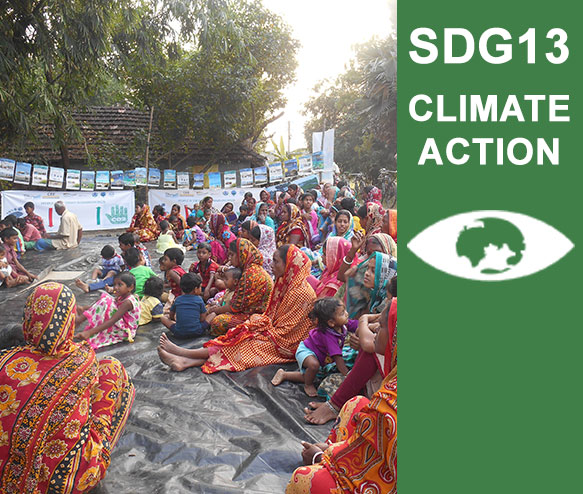SDG13-Climate Action
Climate literacy.
- Climate literacy.
- Marine litter management.
- Climate change adaptation infrastructure.
- Eco-system conservation and bio-engineering.
- Climate resilience.
CREATING CLIMATE RESILIENT FAMILIES IN THE INDIAN SUNDARBANS.
Updated JUNE 2021
Families living in the islands of the Indian Sundarbans are extremely vulnerable to the impacts of climate change, the poor share this vulnerability disproportionately. While sea level rise and coastal erosion has rendered scores of such families homeless and landless, many more continue to be threatened by intensifying tidal surges and recurring cyclones. The Sundarbans is home to some of the “poorest of the Poor” families in the planet, struggling to survive in an unforgiving environment. Their struggles and miseries are compounded by the increasing frequency and intensity of climate events arising out of the warming Bay of Bengal. Cyclones and related events such as “tidal surges” have always been associated with the Sundarbans, however while the really big events were once in decade or more events, the people in the Sundarbans have been battered by 2 Cyclones in 2019, Cyclone “Amphan” during the CPOVID 19 Induced Lockdown in 2020 and recently on May 26th, 2021 when Cyclone “Yaas” made landfall. The tidal surges caused by the Cyclone got amplified in magnitude and intensity due to astronomical alignments and an unsuspecting population suddenly found themselves engulfed in “brackish” water. The inundation persisted for a couple of days, killing flora and fauna and poisoning the soil and water. Perched on roof tops, families watched as everything they owned including their grain and other foodstuff, livestock, clothing, furniture and personal belongings were washed away.
Most families in the Sundarbans survive on remittances from male members who migrate for seasonal or long-term jobs to the southern and western states of India. The COVID 19 Pandemic, sent these people back to their homes. Based on their traumatic experience during returning home, many families decided to defer migration and fight it out with their available resources. Cyclone “Yaas” has wiped out their determination and resolve, and families – men, women and children having lost their homes and livelihoods are now forced to think of migration. Hoping to earn back their way to their villages or settling down elsewhere.
The number of “Climate Refugees” is swelling and expected to increase manifold in the coming years.
Somewhere, the plight of the poor people in a small part of the world, does not seem to bother the mainstream. After every natural disaster, the government and non-government agencies engage in relief activities which driven by media, is short-lived. Thereafter there is nothing. While the Government does initiate some action to reduce vulnerability, these are mostly not well thought out and political interests hinder implementation. Civil society organizations are plagued by resource and capacity crunch and their contribution to vulnerability reduction is insignificant. The lack of foresight and concerted thinking, planning and implementation amongst stakeholders is worrying and unless significant changes are made in the way we think and act about Climate Change and its impact particularly on the poor, more and more families from the Sundarbans will be forced to abandon their homes and lands for a chance at a life, in slums and unregulated settlements in cities across the country.
Understandably, it is a very difficult and almost hopeless situation. CSS has invested significant resources in the past couple of years with funds raised from friends and relatives to build the capacity of people to cope with their environmental risks, however everything was washed away by “Yaas”. Should we also give up on these people, thinking it to be a waste of our hard-earned money. We suppose not, giving up is easy, hanging in there with a renewed determination to make things better by understanding and analysing better, should be the “humanitarian” way to do things. Our biggest learning, following the devastation of “Yaas” has been that conventional solutions to issues do not work in the Sundarbans and that we should go back to our drawing boards , design brand new solutions and demonstrate how these new solutions work.
We intend to continue to work with the communities in the island Gram Panchayat of Mousini, overlooking the Bay of Bengal. We are reassessing our intervention strategies and intend to use the island and its people to demonstrate a sustainable model of development that takes the climate risks into account. Families will be provided with the knowledge and skills required to cope with their environmental risks and become climate resilient.
While the medium and long-term strategies for creating ” climate resilience” is currently being developed. We have currently identified the following activities that should be taken up for implementation.
- Retrofitting and flood proofing all drinking water sources in the Gram Panchayat.
- Retrofitting / reconstructing household latrines.
- Retrofitting community infrastructure such as embankments, drainage canals, schools, anganwadicentres and health centres to make them climate resilient.
- Promoting appropriate “salt tolerant” paddy with farmers.
- Promoting “Sustainable Fishing” [ fresh water]
- Promoting community enterprises in both farm and non-farm sectors.
- Promoting ” improved health & hygiene” seeking behaviour.
- Promoting ” Climate Literacy” among children and young adults.
Budget: To take care of the costs of delivering the short-term objectives within the current financial year, we have budgeted for RS. 30,00,000.00 [ Rupees Thirty Lakhs only]



















